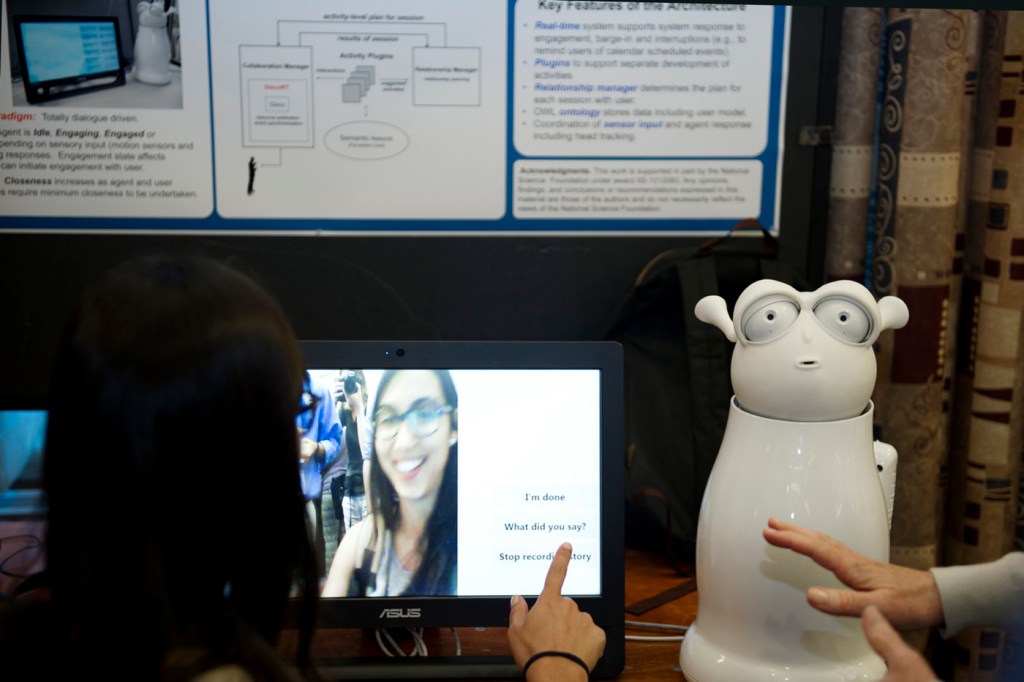Virtual healthcare agents, at your service

Northeastern University last week convened an interdisciplinary group of researchers for the 2014 International Conference on Intelligent Virtual Agents. The annual conference—which this year focused on healthcare applications—is a leading scientific forum for presenting research on modeling, developing, and evaluating intelligent virtual agents with a focus on communicative abilities and social behavior.
Intelligent virtual agents, or IVAs, are interactive characters that exhibit human-like qualities such as real-time perception, cognition, and action, and they can communicate with humans or with each other using natural human modalities such as facial expressions, speech, and gesture.
This year’s conference, held Aug. 27-29, drew more than 125 experts from 11 countries. IVA 2014 was co-organized by Northeastern faculty members Timothy Bickmore and Stacy Marsella. Bickmore, an associate professor in the College of Computer and Information Science and one of the leaders of Northeastern’s personal health informatics program, develops and studies relational agents capable of emulating face-to-face interaction with people and in recent years has focused on avatars for patient education and changing health behaviors. Marsella, who joined Northeastern’s faculty in January and holds joint appointments in the College of Science and the College of Computer and Information Science, develops programs that simulate human emotion across a variety of applications. One of his programs, Cerebella, gives virtual humans the same ability to convey emotion through facial expressions and hand gestures as they communicate with other virtual—or even real—humans.
In the conference’s first keynote address, Dr. Joseph Kvedar, founder and director of the Center for Directed Health at Partners Healthcare, said projected future shortages of physicians and nurses underscore the need for more relational agents in healthcare settings. Kvedar, an internationally recognized expert in connected health and telemedicine, said virtual agents can supplement healthcare professionals’ work by automating certain services, thereby increasing efficiencies and reducing costs. The onset of such avatars dovetails with the healthcare industry’s trending toward preventative care and wellness. As Kvedar put it, “How can we effectively use technology to scale our people across consumers and patients, keeping them healthy and out of the high-cost part of the system?”
Maximizing patient engagement—particularly though personalized methods that employ motivational coaching, games, or social networking—with these agents is critical to improving health outcomes, Kvedar said. His center’s work includes studies that have employed algorithm-driven automated engagement methods, like text messaging, that target areas like diabetes, blood pressure, smoking cessation, and even sunscreen use. Other projects have involved virtual agents; several years ago, Kvedar teamed up with Bickmore for a study at the Boston Medical Center that used a virtual agent to motivate participants to meet walking goals.
These kinds of relational agents discussed at the conference also sprung into action at a research expo on Wednesday night. Several featured Bickmore’s relational agents being used in a variety of healthcare scenarios, among them avatars that offer social support for isolated elderly adults, help women establish healthier behaviors before and during pregnancy, and educate people in Hispanic communities at a high risk for cardiovascular disease.
Other projects featured included a nurse-training program developed at the University of Florida’s Virtual Experiences Research Group in which nurses are challenged in a virtual setting to speak up to the surgeon and anesthesiologist prior to a patient’s surgery. Another simulated crowds and social gatherings in a virtual Reykjavik, Iceland, with one application being to teach Icelandic to tourists and other non-native speakers.

Timothy Bickmore, an associate professor in the College of Computer and Information Science and one of the leaders of Northeastern’s personal health informatics program, develops and studies relational agents capable of emulating face-to-face interaction with people and in recent years has focused on avatars for patient education and changing health behaviors. Northeastern University photo.
But before you introduce a virtual agent to a patient, you first have to create one that’s operational, effective, and lifelike. With that in mind, Terrence Masson, executive professor and head of animation in Northeastern’s College of Arts, Media and Design, on Thursday morning discussed the history of breakthroughs in animation technology.
In his keynote, Masson explored the history of computer graphics technology and shared some of his own experiences working in the industry on more than 20 feature films—from Star Wars to Hook to Terminator 2—as well as commercials and video games. He frequently cited the value of collaborating on visual effects projects, which often combine expertise and vision; collaboration, he said, is similarly important to those in attendance who are building virtual agents.
During a Q-and-A, one audience member asked how developers of virtual agents in healthcare settings can create relational agents that have similarly strong emotional connections with patients that exist in films between virtual and human characters. In response, Masson suggested the answer could be in the storytelling.
“It has a lot to do with empathy,” said Masson, offering that a healthcare avatar might have a personal story to which the patient can relate. “I think it requires either that background narrative or personal empathy with that character.”





